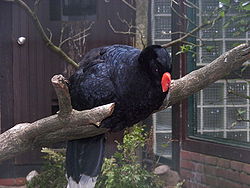- Alagoas Curassow
-
Alagoas Curassow 
Mounted skeleton at the AMNH Conservation status Scientific classification Kingdom: Animalia Phylum: Chordata Class: Aves Order: Galliformes Family: Cracidae Genus: Mitu Species: M. mitu Binomial name Mitu mitu
(Linnaeus, 1766)Synonyms - Mitu mitu mitu
- Crax mitu (Linnaeus, 1766)
The Alagoas Curassow, Mitu mitu, is a large, mainly glossy black pheasant-like bird. It was formerly found in forests in north-eastern Brazil, but it is now extinct in the wild. A captive population exists. Due to confusion over its true taxonomic status, it has formerly included the superficially similar and far more common Razor-billed Curassow as a subspecies.
Contents
Description
The Alagoas Curassow has a total length of approximately 89 centimetres (35 in). It has a whitish-tipped red bill, black glossed purplish blue plumage, chestnut crissum, reddish brown iris and fourteen tail feathers that are tipped pale brown. It has a unique bare greyish crescent-shaped ear patch not found in other curassows. The female is slightly lighter than the male. Its diet consists mainly of fruits and nuts.
Taxonomy
The Alagoas Curassow was first mentioned by German naturalist Georg Marcgraf in his work Historia Naturalis Brasiliae which was published in 1648. Because of lack of information and specimens, it was considered the same species as the far more common Razor-billed Curassow, until after its rediscovery in 1951 in the Alagoas lowland forests, Brazil. Following the review of Pereira & Baker (2004), they are today believed to be a fairly basal lineage of its genus and closer to the Crestless Curassow, the other Mitu species with brown eumelanin in the tail tip. Its lineage is distinct since the Miocene-Pliocene boundary (little more than 5 million years ago), when it became isolated in the refugium in the Atlantic Forest (Pereira & Baker 2004).
Status
The Alagoas Curassow became extinct in the wild due to deforestation and hunting. The last wild Alagoas Curassow was seen and killed in 1984, or possibly 1987 or 1988. The captive population has been extensively hybridized with the Razor-billed Curassow,[1] and there are a few dozen purebred birds left. These are being maintained and bred in two privately-owned professional aviaries in Brazil mainly due to lack of official interest owing to the long-standing doubt about the taxon's validity. They can reach an age of more than 24 years in captivity.
The Alagoas Curassow is protected under Brazilian law and is listed on Appendix I of CITES.
References
- BirdLife International (2000): Alagoas Curassow. In: Threatened Birds of the World: 132. Lynx Edicions & BirdLife International, Barcelona & Cambridge, UK. ISBN 0-946888-39-6
- BirdLife International (2004). Mitu mitu. 2006. IUCN Red List of Threatened Species. IUCN 2006. www.iucnredlist.org. Retrieved on 24 Oct 2006. Database entry includes justification for why this species is extinct in the wild.
- Pereira, Sérgio Luiz; Baker, Allan J.& Wajntal, Anita (2002): Combined nuclear and mitochondrial DNA sequences resolve generic relationships within the Cracidae (Galliformes, Aves). Systematic Biology 51(6): 946-958. doi:10.1080/10635150290102519 PMID 12554460 PDF fulltext
- Silveira, Luís Fábio; Olmos, Fábio & Long, Adrian J. (2004): Taxonomy, history, and status of Alagoas Curassow Mitu mitu (Linnaeus, 1766), the world’s most threatened cracid. Ararajuba 12(2): 125-132. PDF fulltext
Footnotes
- ^ Another case of successful interbreeding between quite distant species, as is often found in cracids. See for example Crax species.
External links
Categories:- IUCN Red List extinct in the wild species
- Mitu
- Birds of Brazil
Wikimedia Foundation. 2010.

